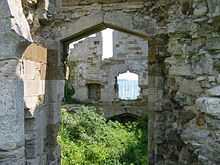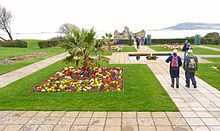Sandsfoot Castle
Sandsfoot Castle is one of Henry VIII's Device Forts, also known as Henrician Castles, built around 1541 to the west of Weymouth, Dorset, England, opposite its contemporary Portland Castle. Together these two forts put the whole of Portland harbour and the roads within range of their artillery, thus protecting shipping from foreign raiders, and preventing an invading landing force from forming up offshore, although the castle was always vulnerable to attack from a landward direction. Most of the castle has fallen into the sea, however the ruins have been Grade II* Listed since late 1953.[1]
History
Military use

The castle dates back to 1539 and was completed in 1541, by Henry VIII as an artillery castle. It was designed specifically as part of the king's network of coastal defences to protect against both French and Spanish attacks, based on the possibility of attacks by Roman Catholic enemies due to the change in the established religion in England.[2] It was completed two years after its contemporary Portland Castle. The castle went under repair in 1584 due to damage suffered by coastal erosion and undermining by the sea. Remedial works were later undertaken in 1610-11 and again in 1623. From 1642, the castle often changed hands and was held for the King by the Royalist during the English Civil War. However, in 1644-45, the castle was surrendered to Parliamentary forces by, governor for the king, Colonel Ashburnham.[3][4] It was also considered to be of no military importance and of no further use to the Royalists. Afterwards the castle dungeons were used as a mint for striking coinage during the war, giving it a greater importance to both defenders and attackers. The castle never saw serious military action and was dropped from the Military Register in 1665.[5]
Abandonment and ruin

After being dropped by the Royalists, the castle was held by governor Humphrey Weld for a long time for the government, who eventually left the castle as its condition declined. The castle was used as a storehouse until 1691.[6][1] Following its role as a storehouse, the castle became fully abandoned for centuries and was left to crumble away into the sea. By the end of the 17th century, the castle was becoming a ruin, and in 1837, the southern section fell into the sea, whilst the gun deck also fell into the sea during the 18th century.[4] Since the completion of the enclosure of Portland Harbour in the late 19th century, the castle was greatly protected from the tide and was therefore less under threat from coastal erosion. However, it became more under threat from land instability which caused further erosion to the structure. Over the years, much of the castle's facing stone was removed, especially from the easily reached lower levels, and was used in other structures, including the foundations of Weymouth's Town Bridge in the 19th century. It was the first stone bridge between Weymouth and Melcombe Regis. In 1876, a short novel titled "The Poisoned Cup" by Joseph Drew was set in the reign of Elizabeth I and used Sandsfoot Castle as its backdrop.[5]
In 1902, Weymouth Corporation purchased the castle from the Department of Woods and Forests for a total of £150. In 1930, the castle was declared unsafe and closed to the public, although Tudor style gardens were laid out in front of the castle in 1931.[7] During the Second World War an anti-aircraft battery was positioned at the castle.[3] Throughout the 20th century, it remained out of bounds via fencing due to continued safety concerns and to protect visitors from falling masonry. In 2003, the castle was listed on the English Heritage Buildings At Risk Register, when it was in need of urgent work.[8] The Royal Coat of Arms carved in stone was removed from the castle and today remains over the south door of All Saints' Church in Wyke Regis.[5] Being Tudor, the lion rampant is joined at the shield by a wyvern rather than the unicorn.[9]
Restoration

In late 2009, however, a proposed restoration project was put forward after the Heritage Lottery Fund awarded £23,100 to carry out a specialist survey of the castle. The money was given both to the Friends of the Rodwell Trail and Weymouth and Portland Council who together expressed a wish to reopen the ruined building as a tourist attraction. The proposed project planned to stabilise, preserve and monitor the structure of the castle, thus making it safe for public access.[10]
In early 2011 the Heritage Lottery Fund made a grant of £194,700 to pay for the castle to be restored so it could be opened to the general public. The plans included a new platform on the interior walls, as well as installation of floodlighting and information panels.[8] The restoration work was completed in 2012, in time for the Olympic Games when the sailing events took place at the Isle of Portland. The castle's opening was on 1 July 2012 as part of the area's fourth annual Tudor Fayre within the Sandsfoot Gardens.[11] Shortly after, the Friends of the Rodwell Trail group used Digibug to create a website based on the castle and the Rodwell Trail, in order to refurbish their online presence and promote the local landmarks.[12]
The restoration work was carried out by SSHConservation and consisted of stabilisation of the masonry and the construction of an internal walkway that follows the inside of the walls. This walkway design was considered with care to lessen impact on the ruin. A small viewing gallery was also created, overlooking Portland Harbour and the area of the gun platform, which had fallen into the sea many centuries ago. A historical booklet and a free guide was also to be produced. This restoration made the area more accessible and ensured conservation of the castle for future generations.[7] The progress made has given hope that the site will be removed from the Heritage at Risk Register in 2013.[4]
In November 2012, the design of the castle and grounds was the winner in Weymouth Civic Society's annual awards. Judges praised the renovation of the site, turning it into a "crowning attraction" of the area and also praised the development for its intimate and close-knit layout, original design and pleasing appearance.[13]
Design

The castle was built at a cost of £3887-4s-1d. The castle was rectangular with two storeys and dungeons. The basement provided an emplacement for heavy cannon emplacement, underground powder magazines and quarters for about fifty men. It was protected by a ditch and a series of earth ramparts.[5] The bastion earthworks were probably added in 1610-11 during remedial works, whilst later bastion earthworks were added in the early 17th century before the castle was abandoned.[3] The castle is orientated on a north-west/south-east axis. The castle was made of Portland stone rubble with a facing of ashlar. Evidence suggests that some of the stone used in the construction possibly came from earlier local ecclesiastical buildings that were destroyed after the Dissolution of the Monasteries, notably the Cistercian monastery Bindon Abbey, near Wool.[5]
The castle originally had a central block of 2 storeys and basement, with an entrance gate, as well as an octagonal gun-room on the seaward side. Today the outer walls and the castle's gatehouse remain much decayed, whilst the gun-room has largely been a victim of coastal erosion and its platform has fallen into the sea many centuries ago. Outside, the castle's entry front has left side remains of the gatehouse over an entry with a straight-sided low arch. The right side has remains of walling to the basement, ground and first floors, with ashlar remnants to the upper level, as well as very steep sloping sills. Beneath are 6 lights to peaked heads which are in unfaced walling, and feature 5 square-headed openings to the castle's basement level. The opposite side has 4 casements in some ashlar facing, which are above 4 openings to the main level, whilst the basement level is below ground level on this side. The castle is completely unroofed and has no floors or fittings except for remains of a fireplace and doorways at the seaward end.[1]
Area

The site is easily accessible as a local garden and lies nearby the Rodwell Trail, a short-distance footpath that runs from Wyke Regis to the town centre of Weymouth via the route of a disused railway line. Also close by is the sandy beach Castle Cove, also known as Sandsfoot Cove, which lies adjacent to the remains of Sandsfoot Castle and is backed by low cliffs. The small cove is privately owned.[14] As a sheltered and sandy area, Castle Cove is popular for swimming, sailing, snorkelling and diving.[15]
Sandsfoot Gardens form the grounds around the ruins of the castle. Originally designed in 1931, the gardens have remained popular with local people for many decades. The small gardens are made up of seasonal flowers, herb beds and herbaceous borders, which surround an ornamental pond, with a fountain, in the centre of the grounds. A new cafe and terraced area was re-established at the entrance of the gardens in the summer of 2006.[7] The defensive earthworks of the castle now form part of landscaped gardens.[3] The wooden bridge leading from the gardens to the castle was removed around 2002-3 but has since been replaced with a new wooden bridge.[2]
References
- ↑ 1.0 1.1 1.2 "The National Heritage List for England | English Heritage". List.english-heritage.org.uk. 1953-12-12. Retrieved 2013-02-11.
- ↑ 2.0 2.1 "Weymouth,Dorset,England - Sandsfoot Castle, Weymouth". Weymouth-dorset.co.uk. Retrieved 2013-02-11.
- ↑ 3.0 3.1 3.2 3.3 "Detailed Result: SANDSFOOT CASTLE". Pastscape. Retrieved 2013-02-11.
- ↑ 4.0 4.1 4.2 "Sandsfoot Castle". English Heritage. Retrieved 2013-02-11.
- ↑ 5.0 5.1 5.2 5.3 5.4 "& The Rodwell Trail". Sandsfoot Castle. Retrieved 2013-02-11.
- ↑ "Result Detail". Heritage Explorer. 2003-07-09. Retrieved 2013-02-11.
- ↑ 7.0 7.1 7.2 "Sandsfoot Gardens". dorsetforyou.com. Retrieved 2013-02-11.
- ↑ 8.0 8.1 "BBC News - Lottery cash for crumbling Sandsfoot Castle in Weymouth". Bbc.co.uk. 2011-01-06. Retrieved 2013-02-11.
- ↑ "Sandsfoot Castle, Weymouth". Visitweymouth.co.uk. Retrieved 2013-02-11.
- ↑ "Restoration hope for castle ruin". BBC News. 2009-12-21. Retrieved 2013-02-11.
- ↑ "Revamped Sandsfoot Castle will open this weekend (From Dorset Echo)". Dorsetecho.co.uk. 2012-06-29. Retrieved 2013-02-11.
- ↑ "raises Sandsfoot Castle website from the ruins | Digibug raises Sandsfoot Castle website from the ruins". Digibug. 2011-12-08. Retrieved 2013-02-11.
- ↑ "Top award for Sandsfoot Castle, Henry VIII's iconic monument (From Dorset Echo)". Dorsetecho.co.uk. 2012-11-24. Retrieved 2013-02-11.
- ↑ "Sandsfoot Castle Cove Beach in Dorset". Dorsetinfocus.co.uk. Retrieved 2013-02-11.
- ↑ "Sandsfoot Castle (Portland Harbour ) Beach | Dorset | UK Beach Guide". Thebeachguide.co.uk. Retrieved 2013-02-11.
Further reading
- Colvin, H.M. (ed) (1982). The History of the King's Works, Vol. IV, 1485–1600, Part II.
- Drew, Joseph (1876). The Poisoned Cup: a quaint tale of old Weymouth and Sandsfoot Castle in the days of Queen Bess. Reprinted many times up to 1963. Weymouth: Sherren & Son.
- Harrington, Peter (2007). The castles of Henry VIII. Oxford: Osprey. ISBN 978-1-84603-130-4
- Morley, B. M. (1976). Henry VIII and the development of coastal defence. London: H.M. Stationery Office. ISBN 0-11-670777-1
See also
- Castles in Great Britain and Ireland
- List of castles in England
- List of Dorset beaches
- Jurassic Coast
External links
| ||||||||||||||
Coordinates: 50°35′42.8″N 2°27′38.96″W / 50.595222°N 2.4608222°W